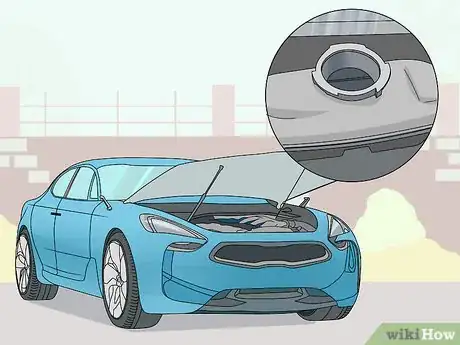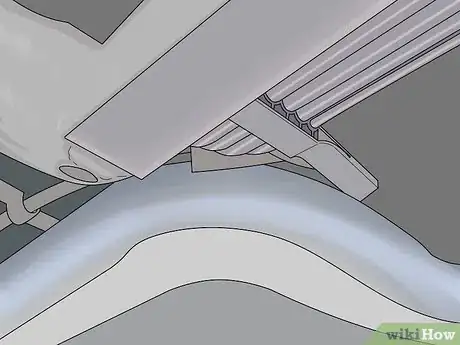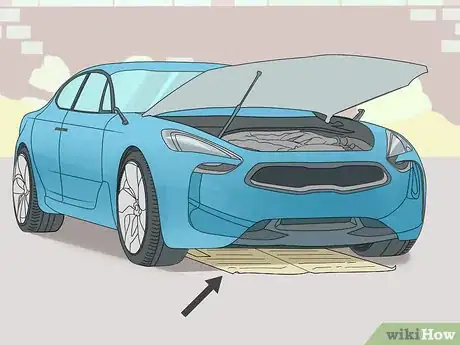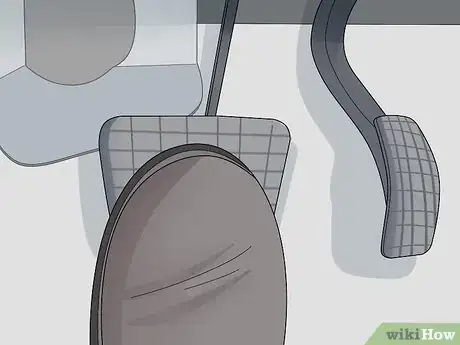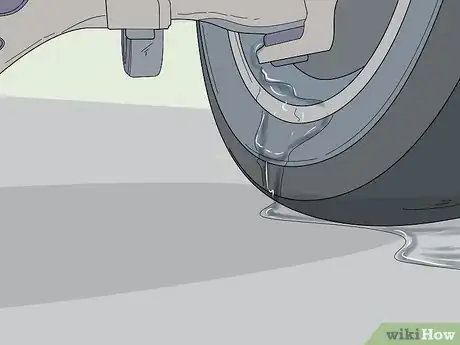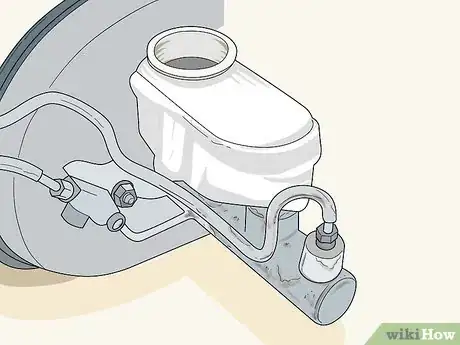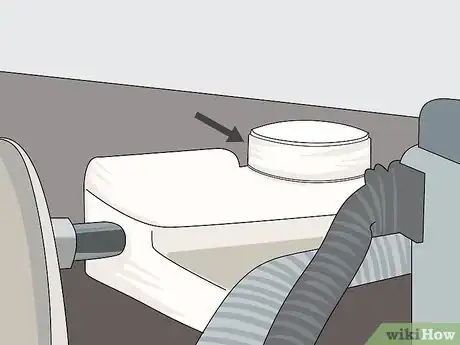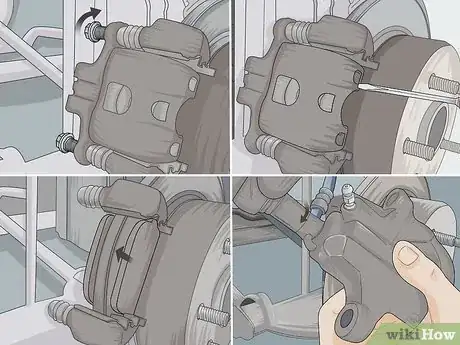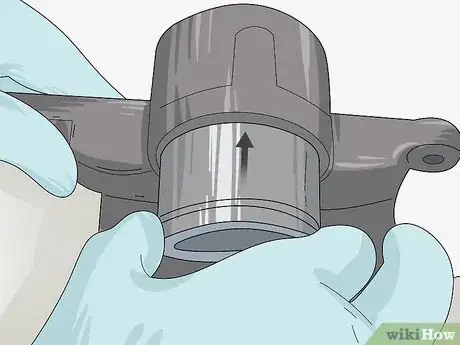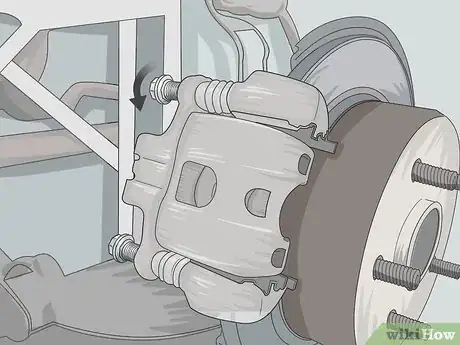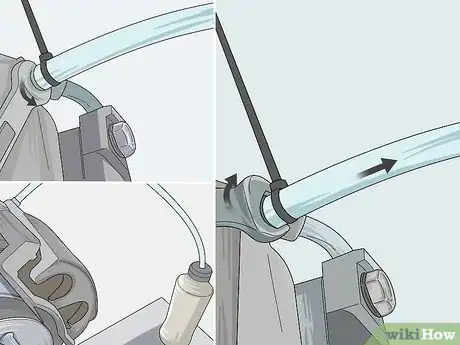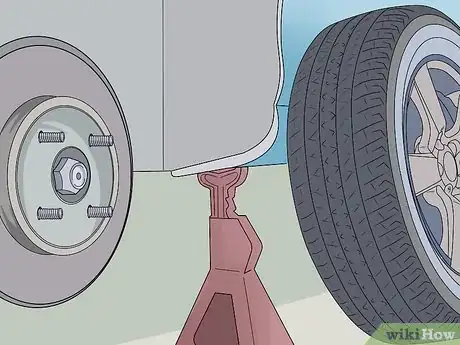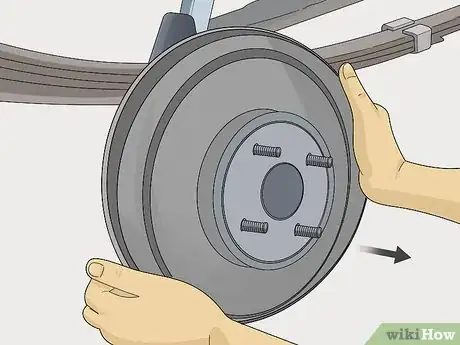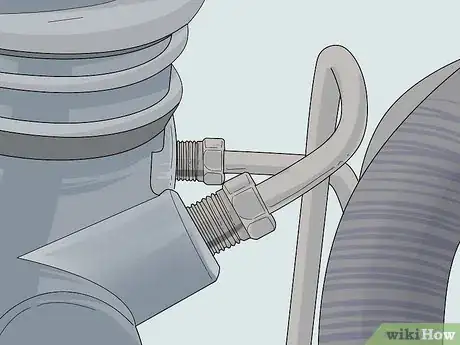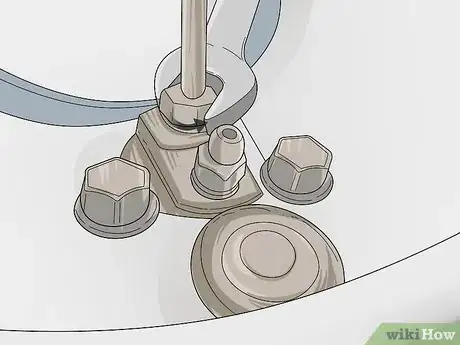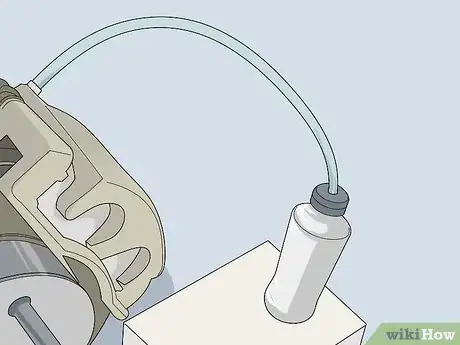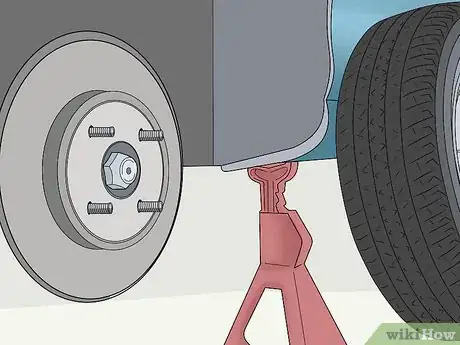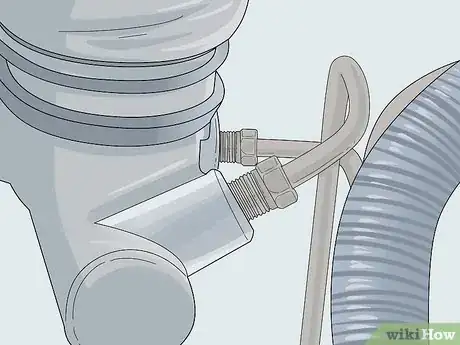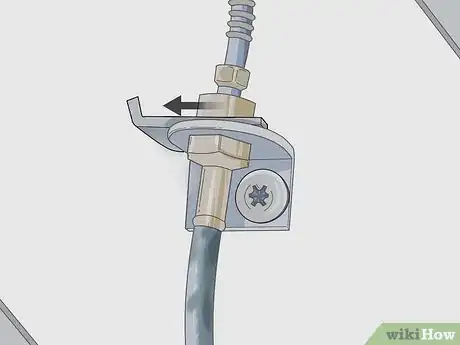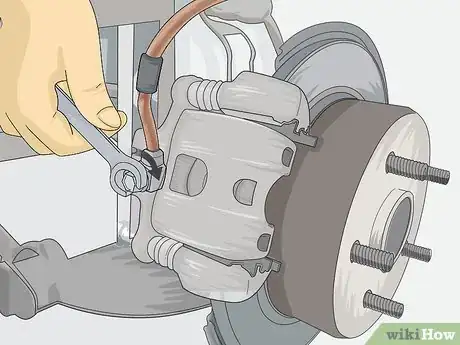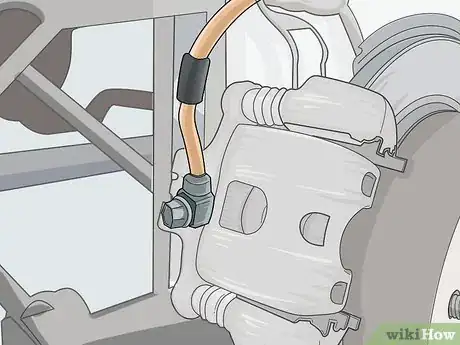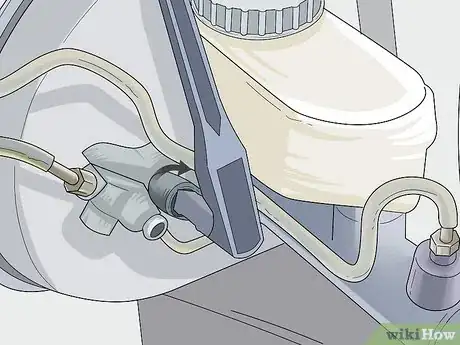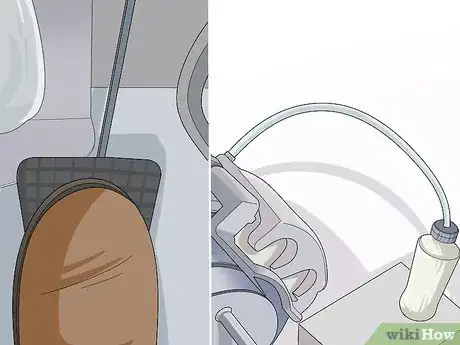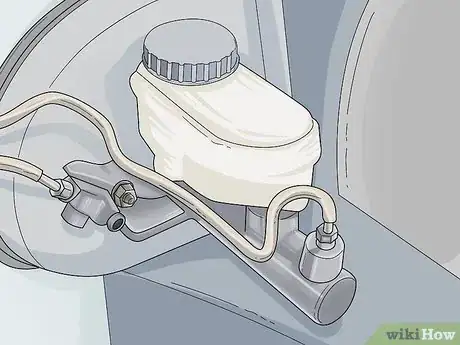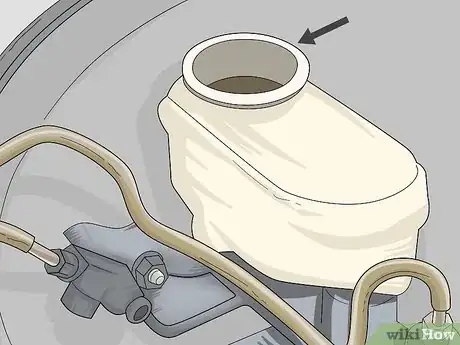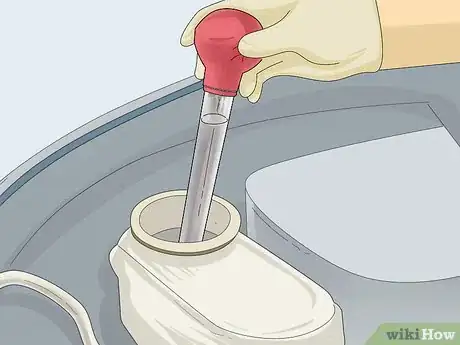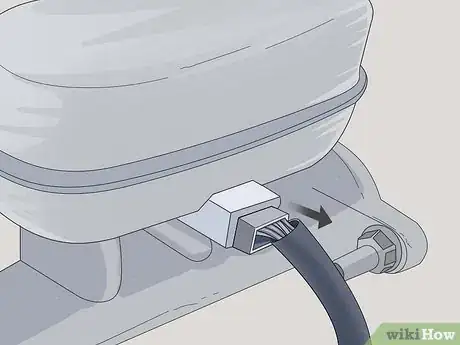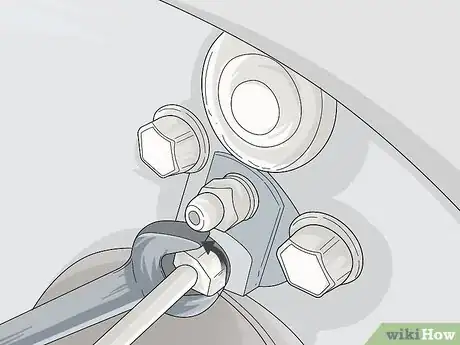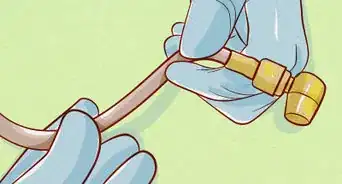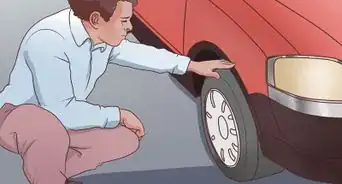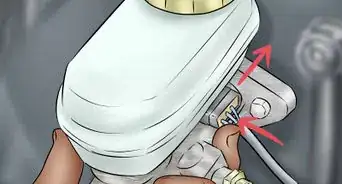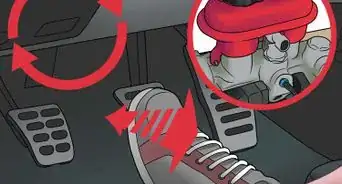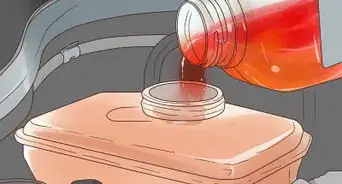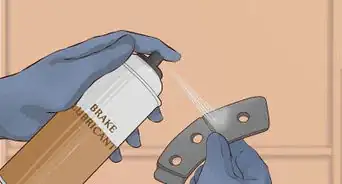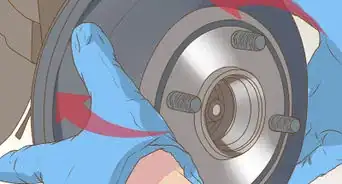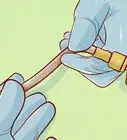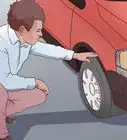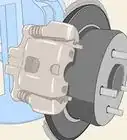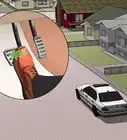This article was co-authored by Andrew Everett. Andrew Everett is a Master Mechanic in Cary, North Carolina. He has an Associates in Applied Sciences focusing on Industrial Technology from Central Carolina Community College and has been doing automotive repair since 1995.
wikiHow marks an article as reader-approved once it receives enough positive feedback. In this case, 97% of readers who voted found the article helpful, earning it our reader-approved status.
This article has been viewed 591,686 times.
When your brake light comes on, your brake responsiveness fades or your brake pedal begins to sink toward the floor, you may have a brake fluid leak. Another telltale symptom is a fresh puddle of fluid beneath your car; in this case, the fluid is colorless and it’s not as heavy as other engine oils, so it has a consistency similar to that of cooking oil.
Steps
Finding the Leak
The first step to repairing a brake fluid leak is to diagnose its placement and severity. Once you have determined the location and severity of the leak, then you will need to make the actual repair.
-
1Open the hood and check the brake fluid reservoir. This reservoir is located on the driver’s side toward the rear of the engine compartment. If fluid is low, then you may have a leak.
-
2Verify the leak by checking beneath the car for the presence of brake fluid. The location of the brake fluid will also help you to locate the general placement of the leak.Advertisement
-
3Place newspapers on the ground beneath the general location of the leak.
-
4Pump the brake pedal to force fluid out through the leak. Make sure that your car is NOT turned on for this process. Turning on the car would cause the brake fluid to squirt out very quickly and would make the leak hard to control, depending on its severity.
-
5Crawl underneath the car and look for the spot where fluid is dripping from the brakes. If the leak is coming from within a wheel, then you may have to remove the wheel to check for leaks in the lines and calipers.
- It the car has brake drums it may have a leak in the wheel cylinder. You will have to remove the brake drum to check it.
-
6Check the master cylinder for leaks. The master cylinder’s placement varies from car to car and will be given in your owner’s manual. If you no longer have a copy, then check online to find the original manual.
-
7Verify that the master cylinder lid is tightly closed. Sometimes, fluid can leak from a lid that has not been properly fastened.
Rebuilding Brake Calipers
Few mechanics completely rebuild calipers, wheel cylinders or the master cylinder from the ground up. Instead, they send the parts to a central rebuilding station and then reinstall the freshly rebuilt part. It is almost always better to buy a new caliper rather than attempt to rebuild one. The price of calipers has gone down, and they only cost a few more dollars than the rebuild kit. However, anyone who wants to take on the challenge of rebuilding brake calipers can purchase a rebuild kit at an automotive store.
-
1Remove the old caliper.
- Purchase a caliper rebuild kit from an automotive store or dealership.
- Remove the brake bleeder bolt using a flare-nut wrench. If needed, utilize gentle tapping and penetrating oil to loosen the part without breaking it.
- Disconnect both the steel and rubber brake lines using a flare-nut wrench. Replace these lines if they are cracking or worn before putting the calipers back onto the car.
- Strip the calipers of pads, shims, springs and sliders or pins.
- Remove the outer dust seal.
- Place a piece of wood that is slightly thicker than both brake pads stacked together in the caliper behind the piston.
- Release low-pressure compressed air into the inlet port. This should cause the piston to pop out.
-
2Replace the piston.
- Lubricate the new piston that came in the rebuild kit with brake fluid.
- Insert the new piston into the caliper using moderate finger pressure.
-
3Replace the caliper.
- Replace the outer dust seal.
- Replace the pads, shims, springs, and sliders or pins. Use the new parts that came in your repair kit, and discard your old parts.
- Reconnect the steel and rubber brake lines.
- Replace the brake bleeder bolt.
- Test the brakes to make sure they are no longer leaking.
-
4Bleed all air from the brake system.
Replacing a Wheel Cylinder
Failed wheel cylinders may weep brake fluid. Replacing the wheel cylinder with an entirely new unit is much easier and only slightly more expensive than rebuilding the part.
-
1Remove the wheel.
- Remove the hubcap and the tire.
- Raise the car using a jack so that the wheel is off of the ground.
- Remove the lug nuts and the wheel.
- Spray the steel brake line fitting with penetrating oil to loosen any existing rust.
-
2Remove the brake drum.
- Remove the rubber plug behind the backing plate.
- Loosen the self-adjuster (star wheel) to lower the brake shoes. If you turn the self-adjuster in the wrong direction, then the drum will get tighter and will not turn. Use a small flat head screwdriver to release the adjuster arm, if needed.
- You may need to use a hammer to hit the middle of the drum to loosen any rust that surrounds the center piece.
- Remove the drum.
- Place a drip pan beneath the brake shoes. If the brake shoes are covered in fluid, you will need to replace them as well.
- Spray the area with brake cleaner to eliminate dirt and fluid.
-
3Loosen the steel brake line.
- Prepare a vacuum hose to prevent brake fluid from leaking out of the steel brake line. Place a screw or bolt in one end.
- Locate the steel brake line on the plate where it screws into the wheel cylinder and use a line wrench to loosen the brake line fitting.
- Remove the fitting.
- Place the vacuum hose over the line to prevent leakage.
-
4Replace the wheel cylinder.
- Locate the two retaining bolts on the backing plate that hold the wheel cylinder in place.
- Use a socket wrench to loosen the bolts.
- Remove the old wheel cylinder.
- Thread the steel brake line fitting into the new cylinder. Screw it in as far as you can by hand.
- Insert the bolts back into the backing plate and screw them in to secure the new cylinder.
-
5Bleed all air from the brake system. See instructions in method six.
Replacing Steel Brake Lines and Hoses
If brake hoses are cracked and flaking or spongy and sticky, then the hoses should be replaced. If brake lines have patches of rust on them, then sand the rusty spots gently to see if the metal has thinned out. When steel lines have thin spots in the metal walls, replace them.
-
1Remove the tire that is over the leaking brake line.
-
2Unscrew the brake line from the fitting that is closest to the master cylinder. Use the proper flare nut wrench.
-
3Remove all mounting bracket clips that hold the brake line in place.
-
4Disconnect the brake line from the brake caliper using a line wrench.
-
5Loosely attach the new brake line to the caliper. The new brake line should be the same length as the old line.
-
6Reinstall bracket clips with the new line.
-
7Attach the brake line to the fitting closest to the master cylinder using a line wrench.
-
8Tighten all connections.
-
9Bleed all air from the brake system, as described in method six.
Replacing the Master Cylinder
Most modern brake systems are divided into two circuits, with two wheels on each system. In case one circuit fails, the brakes on the other system will still function. The master cylinder supplies pressure to both circuits. Replacing the master cylinder is usually cheaper than having an in-shop rebuild.
-
1Open the hood and locate the master cylinder.
-
2Remove the brake fluid reservoir cap.
-
3Withdraw brake fluid from the master cylinder using a turkey baster. Place discarded brake fluid into a plastic container.
-
4Disconnect all electrical connectors from the master cylinder.
-
5Disconnect the brake lines using a line wrench by turning the line wrench in a counterclockwise motion.
-
6Remove the master cylinder mounting bolts with a socket wrench.
-
7Remove the old master cylinder.
-
8Install the new master cylinder by securing mounting bolts.
-
9Connect brake lines to the new master cylinder with a line wrench.
-
10Connect electrical connectors to the new master cylinder.
-
11Bleed all air from the brake system.
Bleeding Air From the Brake System
After any brake system repair, bleed all air and brake fluid from your system and replace it with new brake fluid. You will need an assistant for this project.
-
1Ask your assistant to sit in the driver’s seat.
-
2Remove the brake fluid reservoir cap on top of the master cylinder.
-
3Draw all of the brake fluid from the master cylinder using a turkey baster. Place the used brake fluid in plastic bottles. Clean out any sediment with a clean, lint-free rag.
-
4Refill the brake fluid reservoir with new fluid. Check the underside of the reservoir cap or your owner’s manual to find out which brake fluid is appropriate for your car.
-
5Loosen the brake fluid bleeder screw located on the caliper or the wheel cylinder at the right rear of the car. You will have to bleed each brake one at a time or you risk drawing air into the system. Start with the right, rear of the car.
-
6Attach a vinyl hose to the bleeder screw.
-
7Place the opposite end of the vinyl hose into a clear plastic bottle.
-
8Ask your assistant to press the brake pedal to the lowest point of its normal travel (you may need a block under the brake pedal to avoid going past this).
-
9Tighten the front right brake fluid bleeder screw after all of the air bubbles are released.
-
10Ask the assistant to pump the brake pedal until the pedal gets hard and builds up pressure. This will draw fluid into the body of the master cylinder. Fluid should squirt into the bottle each time your assistant pumps the brakes. Do this until new, fresh brake fluid starts coming out.
- Keep topping off the master cylinder with more fluid. It should never be more than half empty.
-
11Ask your assistant to press the brake pedal again. Tighten the brake fluid bleeder screw and remove the hose.
- Repeat the process until all four wheels have been bled. Again, you must bleed each brake one at a time.
-
12Top off the master cylinder with brake fluid.
-
13Test the brakes to make sure that they are functioning normally.
Warnings
- Take care not to damage the brake bleeder bolt while disengaging it.⧼thumbs_response⧽
- Follow all local ordinances regarding the disposal of brake fluid.⧼thumbs_response⧽
- Pressing the brake pedal to its lowest possible point when bleeding brakes may damage seals on an old or poorly maintained system, so you should avoid this..⧼thumbs_response⧽
- Follow the manufacturer’s guidelines for raising your car with a jack.⧼thumbs_response⧽
- Always wear protective clothing, eye wear and gloves when dealing with brake fluid⧼thumbs_response⧽
Things You'll Need
- Newspapers to catch leaking brake fluid
- Your owner’s manual
- Flare-nut wrench
- Small block of wood
- Compressed air
- Caliper rebuild kit, if needed
- Flathead screwdriver
- Drip pan
- New brake shoes, if needed
- Penetrating oil
- Brake cleaner
- Small vacuum hose with screw or bolt
- Line wrench
- Socket wrench
- New wheel cylinder, if needed
- New brake hoses and lines, if needed
- New master cylinder, if needed
- Turkey baster
- Plastic bottles
- Vinyl hoses
- An assistant, if needed
References
- http://www.ifitjams.com/braking.htm
- http://www.autos.com/auto-repair/how-to-spot-a-brake-fluid-leak
- http://www.popularmechanics.com/cars/how-to/maintenance/4305927
- http://www.2carpros.com/articles/how-to-replace-a-wheel-cylinder
- http://www.military.com/off-duty/partner/autos/brake-lines.html
- http://www.2carpros.com/articles/how-to-replace-a-brake-master-cylinder
About This Article
If your brake fluid is leaking, first, find the source of the leak by looking underneath the car and spotting where the fluid is dripping. For example, if the leak is coming from the wheel, you may have to remove the wheel and check the lines and calipers. To fix a leaky caliper, purchase a caliper rebuild kit from an automotive store or dealership and remove your car’s brake bleeder. Then, disconnect the steel and rubber brake lines and replace them as well if they look cracked or worn out. Strip everything from the calipers so you can blow low-pressure compressed air into them to pop the piston out. From there, replace the piston and put the caliper back together. For more help from our co-author, including how to fix a leak in the wheel cylinder, read on. For more help from our co-author, including how to fix a leak in the wheel cylinder, read on.
